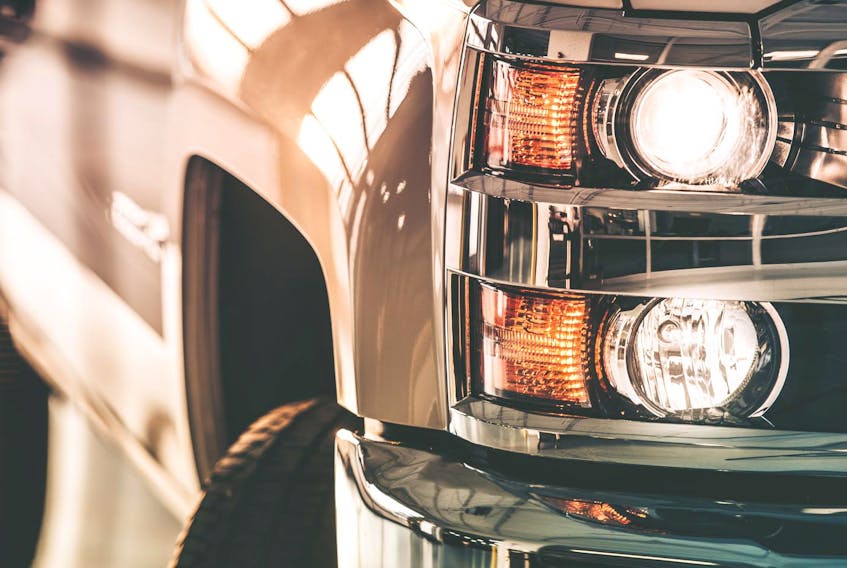Most drivers remember to change the engine oil and check the tire pressures, but one maintenance item often overlooked is aiming the headlights.
None of us would want to go back to the early days of motoring where kerosene lamps were used to show the way.
Electric headlamps were much more convenient. The 1898 Columbia Electric Car had them. When GM started to use them in 1908, the end was near for non-electric lights. Even though the vehicles of the ’20s through ’40s used replaceable bulbs in manufacturer distinctive headlamp units much the same as we do now, the technology wasn’t available that would illuminate the road very far ahead.
A major improvement came with the introduction of the standardized round seal beam units in the late ’40s. Although in Europe, regulations still allowed for headlamps with replaceable bulbs, North American standards mandated the round sealed beams only and later on the rectangular sealed beam units.
By the 1980s the North American sealed beam systems were far behind the European systems and the regulations were changed to allow aerodynamic headlamps with replaceable bulbs. These systems are still in use today, with the only improvement being high intensity discharge (HID) lights and now LED headlights available on some vehicles.
Regardless of the type of lighting system, Transport Canada regulations must be met for the headlamp system to be legally installed on a vehicle. This usually only applies to original manufacture of the vehicle or importation from another country. After the vehicle is here, Provincial highway traffic acts usually regulate what we drive.
One of the requirements is that headlamps and their illumination source (bulb) be Department of Transportation (DOT) approved.
The Tuner enthusiasts sometimes inadvertently run afoul with this regulation when installing after-market headlamps or tail lamp assemblies, but most suppliers are aware of the DOT regulations and only market those systems. Bulbs are another story.
I still see some headlamp bulbs on the market that don’t have the DOT marked on them. There are also bulbs that are cheaply made and don’t always have the filament located correctly inside the bulb.
This affects the headlight aim. Replacement bulbs may be either clear or have a blue tint, as long as they are DOT approved and don’t exceed the maximum wattage specified by Transport Canada.
There are wattage standards for each type of headlamp system, but typically, high-beam headlamps should use no more than 70 watts and low beam no more than 60 watts of power. There are bulbs available rated at 80 or 100 watts but these are for off-road use only. They do provide more light but can blind oncoming drivers.
As for those blue lights, they are usually on vehicles with HID headlamps. The light is a bluish white caused by an arc between two electrodes inside the bulb, similar to an electric welder arc.
They do provide more light but shouldn’t blind oncoming traffic if aimed correctly. HID bulbs are replaced as part of the headlamp unit. Those blue bulbs on the store shelves are for drivers that want to make their car look like it has HID lights, but they don’t necessarily provide more light than regular bulbs.
Headlamp aiming is again regulated by Transport Canada but each manufacturer has their own specifications so the lights will provide maximum illumination without blinding oncoming traffic.
Typically, the low beams are aimed with the front of the vehicle 25 feet away from a wall and the bright spot of the light on the wall located about two inches below the centre height of the headlight.
Low-beam headlamps must have a cutoff so the light does not project up or toward the left into oncoming traffic. High-beam headlamps are aimed so the bright spot is centred at the same height as the headlamp.
Vehicle load affects headlamp aim. Overload the trunk and your headlights will point at the sky. European standards mandate automatic headlamp levelling systems fir HID headlamps and we see some vehicles like Lexus and Mercedes with levelling systems here, although they are not required.
You can visually check your headlamp aim by parking 25 feet from a wall on a dark night and looking at where the lights shine. Low beams should be slightly lower than high beams and level to each other. If they are not, or other drivers are flashing their high beams at you take it to the repair shop to have them aligned. It only takes a few minutes.
Lighting systems are undergoing constant development. Chrysler uses the 25,000-square-foot Automotive Lighting Research Facility at the University of Windsor, Ont. All car lights are not made equal, but keeping them aimed correctly will let both you and oncoming drivers see much more.









